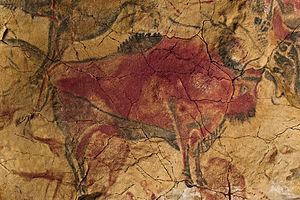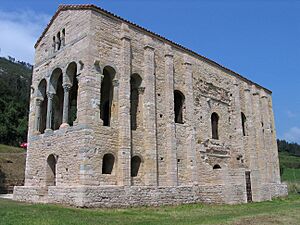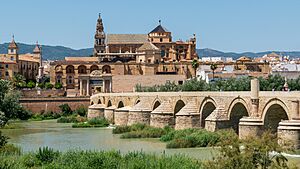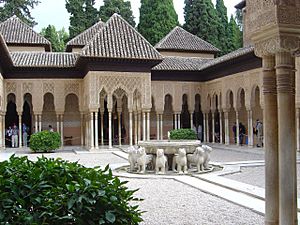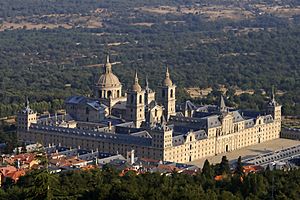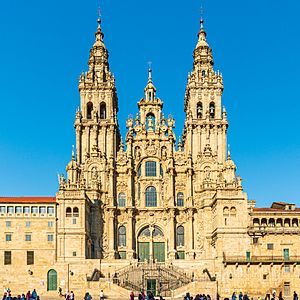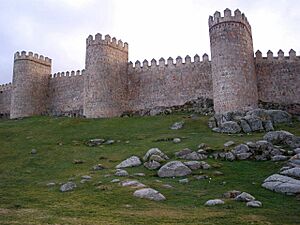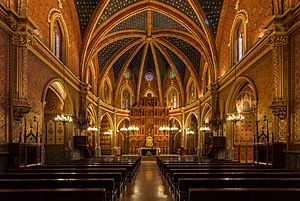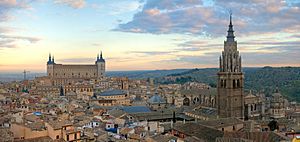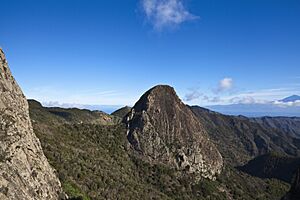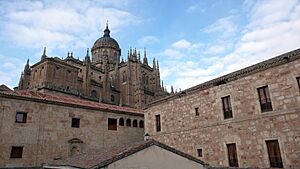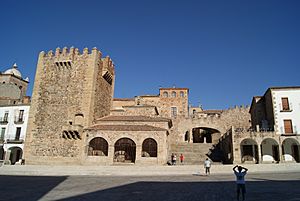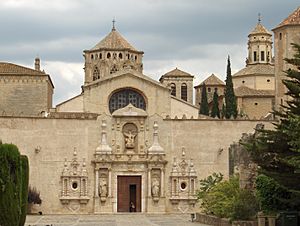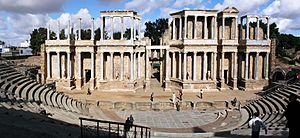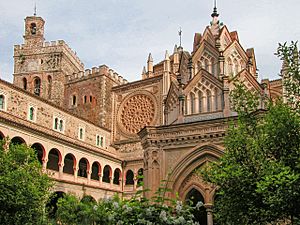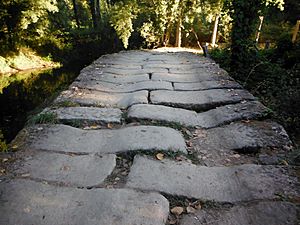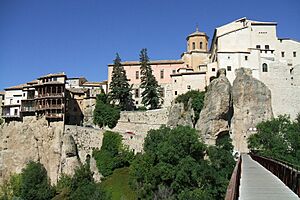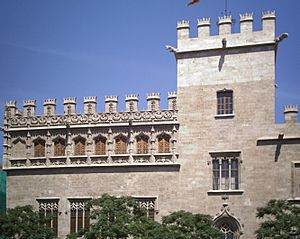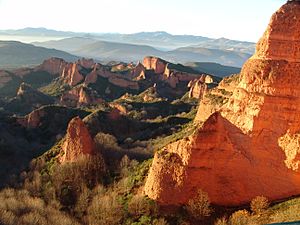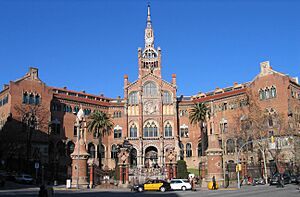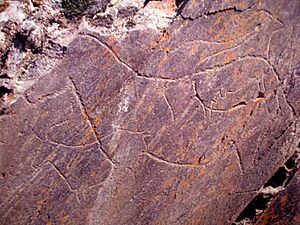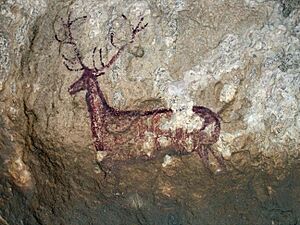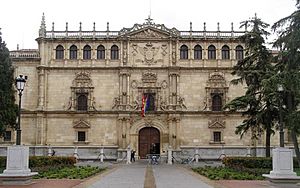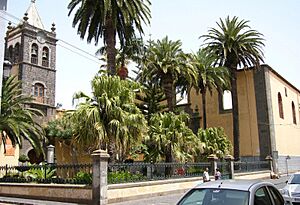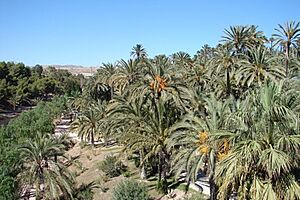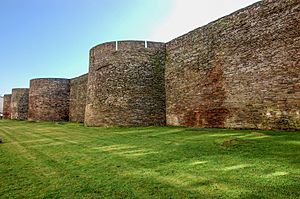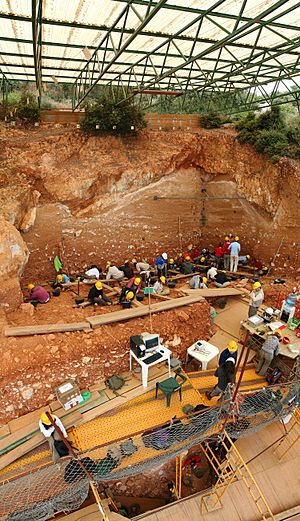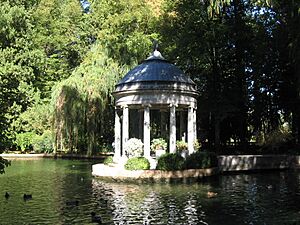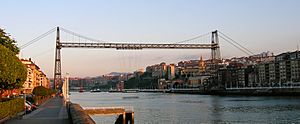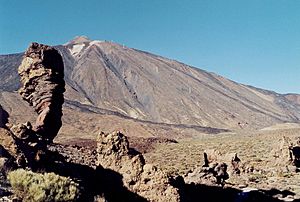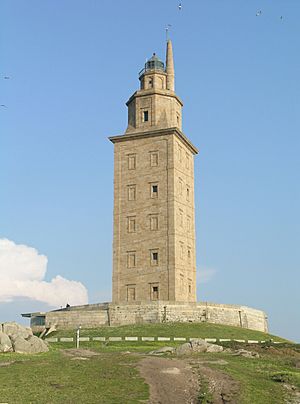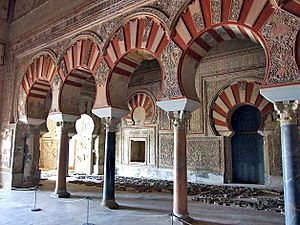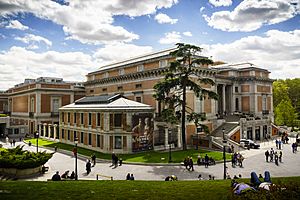List of World Heritage Sites in Spain facts for kids
The United Nations Educational, Scientific and Cultural Organization (UNESCO) helps protect amazing places around the world. These special spots are called World Heritage Sites because they are important for everyone's history or nature. This idea started in 1972 with the World Heritage Convention.
Cultural sites can be old buildings, sculptures, or even ancient ruins. Natural sites are beautiful places like mountains, forests, or areas where rare animals and plants live. Spain joined this effort on May 4, 1982, which meant its own special places could be added to the list.
Spain's first five sites were added in 1984. These included the Great Mosque in Córdoba, the Alhambra in Granada, Burgos Cathedral, the Monastery of El Escorial, and some of Antoni Gaudí's famous buildings in Barcelona. By 2021, Spain had 49 World Heritage Sites. This is one of the highest numbers in the world, just behind Italy, China, and Germany. Most of Spain's sites (43) are cultural, 4 are natural, and 2 are a mix of both.
Some of these sites are found in the Balearic Islands and the Canary Islands. Four sites are shared with other countries. For example, the Pyrenees – Monte Perdido is shared with France. The Prehistoric Rock-Art Sites are shared with Portugal. The Almadén site is shared with Slovenia. And the Ancient Beech Forests are shared with 17 other European countries!
Contents
Spain's World Heritage Sites
UNESCO uses ten different rules to decide if a place can be a World Heritage Site. Each site must meet at least one of these rules. Rules one to six are for cultural sites, and rules seven to ten are for natural sites.
* Transnational site
| Name | Image | Location | Community | UNESCO data | Period | Description |
|---|---|---|---|---|---|---|
| Cave of Altamira and Paleolithic Cave Art of Northern Spain | Santillana del Mar | Cantabria, Asturias, Basque Country | 310; 1985, 2008 (extended); i, iii | Upper Paleolithic | The Altamira Cave has amazing cave paintings from 35,000 to 11,000 BC. These paintings are very old! The site now includes seventeen other decorated caves. They are well-preserved because they are deep inside the earth. | |
| Old Town of Segovia and its Aqueduct | Segovia | Castile and León | 311; 1985; i, iii, iv | 1st to 16th centuries | This site includes a Roman aqueduct built in the 1st century. There's also a medieval palace called the Alcázar of Segovia from the 11th century. The beautiful Segovia Cathedral was built in the 16th century. | |
| Monuments of Oviedo and the Kingdom of the Asturias | Oviedo | Asturias | 312; 1985, 1998 (extended); i, ii, iv | 9th century | In the 9th century, the Kingdom of Asturias was the only Christian area in Spain. It created its own special style of art and buildings. You can see this style in churches and other monuments like La Foncalada. | |
| Historic Centre of Córdoba | Córdoba | Andalusia | 313; 1984, 1994 (extended); i, ii, iii, iv | 7th to 13th centuries | This site started with the Great Mosque of Córdoba. It was first a church, then a mosque, and later a cathedral again. During the time of the Moors, Córdoba was a very grand city with many mosques. | |
| Alhambra, Generalife and Albayzín | Granada | Andalusia | 314; 1984, 1994 (extended); i, iii, iv | 14th century | These three sites show the strong influence of the Moors in southern Spain. The Alhambra fortress and Generalife palace were built by the rulers of Granada. The Albayzín area has many examples of Moorish homes. | |
| Burgos Cathedral | Burgos | Castile and León | 316; 1984; ii, iv, vi | 13th to 16th centuries | This beautiful Gothic-style cathedral was built between the 13th and 16th centuries. It is the resting place of El Cid, a famous Spanish hero. | |
| Monastery and Site of the Escorial | San Lorenzo de El Escorial | Madrid | 318; 1984; i, ii, vi | 16th century | El Escorial is a royal site because the Spanish royal family used to live there. King Philip II designed this palace to show Spain's important role in the Christian world. | |
| Works of Antoni Gaudí | Barcelona | Catalonia | 320; 1984, 2005 (extended); i, ii, iv | 19th and 20th centuries | The buildings by Antoni Gaudí are part of the Modernist style, but they are truly unique. The site includes famous works like Park Güell, Palau Güell, and Casa Milà. Later, more of his works were added. | |
| Santiago de Compostela (Old Town) | Santiago de Compostela | Galicia | 347; 1985; i, ii, vi | 10th and 11th centuries | The Cathedral of Santiago de Compostela is believed to be where the apostle James is buried. It's the end point of the Way of St. James, a famous pilgrimage route. The town was rebuilt in the 11th century after being destroyed by Muslims. | |
| Old Town of Ávila with its Extra-Muros Churches | Ávila | Castile and León | 348; 1985, 2007 (modified); iii, iv | 11th century | The strong defensive wall around Ávila was built in the 11th century. It has 82 towers and 9 gates. It's one of the most complete town walls in Spain. | |
| Mudéjar Architecture of Aragon | Provinces of Teruel and Zaragoza | Aragon | 378; 1986, 2001 (extended); iv | 12th to 17th centuries | This site features buildings in the Mudéjar style. This style mixes traditional Islamic and European designs. It originally included four churches in Teruel and was later expanded to include six more monuments. | |
| Historic City of Toledo | Toledo | Castile-La Mancha | 379; 1986; i, ii, iii, iv | 8th to 16th centuries | Toledo was founded by the Romans and was once the capital of the Visigothic Kingdom. It was important during Muslim rule and the Reconquista. The city shows a mix of Christian, Muslim, and Jewish influences. | |
| Garajonay National Park | La Gomera | Canary Islands | 380; 1986; vii, ix | N/A | This park is mostly covered by laurisilva or laurel forest. This type of forest grew during the Paleogene period and is now rare in mainland Europe. | |
| Old City of Salamanca | Salamanca | Castile and León | 381; 1988; i, ii, iv | 13th to 16th centuries | Salamanca is famous for its university, founded in 1218. It's one of the oldest universities in Spain and Europe. The city center shows many architectural styles, including Romanesque, Gothic, Moorish, Renaissance, and Baroque. | |
| Cathedral, Alcázar and Archivo de Indias in Seville | Seville | Andalusia | 383; 1987; i, ii, iii, iv | 13th to 16th centuries | The Alcázar was built when the Almohad dynasty ruled southern Spain. The cathedral is from the 15th century and holds the tombs of Ferdinand III and Christopher Columbus. The Archivo (Archive) stores documents about the Spanish colonization of the Americas. | |
| Old Town of Cáceres | Cáceres | Extremadura | 384; 1986; iii, iv | 3rd to 15th centuries | The old town of Cáceres mixes Roman, Islamic, Gothic, and Italian Renaissance styles. It has over 30 Islamic towers. | |
| Ibiza, Biodiversity and Culture | Ibiza | Balearic Islands | 417; 1999; ii, iii, iv, ix, x | N/A | The coast of Ibiza has posidonia oceanica, a special seagrass found only in the Mediterranean. This seagrass helps many sea creatures. The island also has old Phoenician ruins, and its walled city parts are from the 16th century. | |
| Poblet Monastery | Vimbodí | Catalonia | 518; 1991; i, iv | 12th and 13th centuries | This monastery was started by the Cistercians in 1151. It's one of the biggest in Spain and is a burial site connected to the Crown of Aragon. | |
| Renaissance Monumental Ensembles of Úbeda and Baeza | Province of Jaén | Andalusia | 522; 2003; ii, iv | 16th century | These two towns were rebuilt in the 16th century using the new Renaissance style. They are some of the first examples of this style in Spain. | |
| Archaeological Ensemble of Mérida | Mérida | Extremadura | 664; 1993; iii, iv | 1st to 5th centuries | Mérida was founded by the Romans in 25 BC. You can still see many Roman remains like a bridge, an aqueduct, an amphitheater, a theater, and a circus. | |
| Royal Monastery of Santa María de Guadalupe | Guadalupe | Extremadura | 665; 1993; iv, vi | 13th to 16th centuries | This monastery is home to Our Lady of Guadalupe, a special shrine found in the 13th century. It became an important symbol during the Reconquista and the spread of Christianity in America. | |
| Routes of Santiago de Compostela: Camino Francés and Routes of Northern Spain | — | Aragon, Castile and León, Galicia, Navarre, and La Rioja | 669; 1993; ii, iv, vi | N/A | The Camino de Santiago is a famous pilgrimage route. It goes from the French-Spanish border to the Cathedral of Santiago de Compostela. People believe the apostle James is buried there. | |
| Doñana National Park | Provinces of Huelva and Seville | Andalusia | 685; 1994, 2005 (extended); vii, ix, x | N/A | This park is where the Guadalquivir River meets the Atlantic Ocean. It has many different natural areas like lagoons, marshes, and dunes. It's a huge home for water fowl during winter. | |
| Pirineos – Monte Perdido* | Province of Huesca | Aragon (shared with France) | 773; 1997, 1999 (extended); iii, iv, v, vii, viii | N/A | This site includes part of the Pyrenees mountains on the border with France. The Spanish side has two of Europe's largest canyons. | |
| Historic Walled Town of Cuenca | Cuenca | Castile-La Mancha | 781; 1996; ii, v | 12th to 18th centuries | The Moors built this fortified city in the 8th century. Christians captured it in the 12th century. Its cathedral is the first Gothic example in Spain. The town is also known for its casas colgadas, houses that hang over a cliff! | |
| La Lonja de la Seda de Valencia | Valencia | Valencian Community | 782; 1996; i, iv | 15th and 16th centuries | La Lonja de la Seda means "Silk Exchange." These Gothic buildings show how rich Valencia was as an important trading city in Europe during that time. | |
| Las Médulas | Ponferrada | Castile and León | 803; 1997; i, ii, iii, iv | 1st to 3rd centuries | The Romans mined gold here for 200 years. They used a clever method of hydraulic mining, cutting aqueducts into cliffs to bring water. The mining left behind unique cliff faces that you can still see today. | |
| Palau de la Música Catalana and Hospital de Sant Pau, Barcelona | Barcelona | Catalonia | 804; 1997; i, ii, iv | 20th century | Both buildings were built in the early 1900s by Lluís Domènech i Montaner. They are great examples of the Modernist or Art Nouveau style that was popular in Barcelona. | |
| San Millán Yuso and Suso Monasteries | San Millán de la Cogolla | La Rioja | 805; 1997; ii, iv, vi | 6th to 16th centuries | The older Suso monastery was founded in the mid-6th century. It's where the Glosas Emilianenses were written, which are thought to be the first written examples of the Spanish and Basque languages. The newer Yuso monastery was built in the 16th century. | |
| Prehistoric Rock-Art Sites in the Côa Valley and Siega Verde* | — | Castile and León (shared with Portugal) | 866; 1998, 2010 (extended); i, iii | Paleolithic | This site has amazing Upper Paleolithic rock art. It includes 645 engravings in Spain's Siega Verde area. These sites have the best-preserved open-air Paleolithic art in the Iberian Peninsula. | |
| Rock Art of the Mediterranean Basin on the Iberian Peninsula | — | Andalusia, Aragon, Castile-La Mancha, Catalonia, Murcia, and Valencia | 874; 1998; iii | Prehistoric | This site has over 750 examples of rock art from prehistoric times. The images show everything from simple shapes to scenes of people hunting animals. | |
| Archaeological Ensemble of Tárraco | Tarragona | Catalonia | 875; 2000; ii, iii | 1st to 4th centuries | Tárraco was an important Roman city, now modern-day Tarragona. It was the capital of Roman provinces. You can still see parts of the Tarragona Amphitheatre and other Roman ruins. | |
| University and Historic Precinct of Alcalá de Henares | Alcalá de Henares | Madrid | 876; 1998; ii, iv, vi | 16th century | Cardinal Cisneros founded the University of Alcalá in 1499. It was the first planned university city and became a model for others. The city is also the birthplace of Miguel de Cervantes, who wrote Don Quixote. | |
| San Cristóbal de La Laguna | San Cristóbal de La Laguna | Canary Islands | 929; 1999; ii, iv | 16th to 18th centuries | This city has an old, unplanned upper town and a planned lower town. It was Spain's first colonial town that wasn't fortified, and it became a model for cities in America. Many buildings from the 16th century are still there. | |
| Palmeral of Elche | Elche | Valencian Community | 930; 2000; ii, v | N/A | This grove of date palm trees was set up with irrigation systems by the Moors in the 10th century. It's a rare example of Arab farming methods in Europe. | |
| Roman Walls of Lugo | Lugo | Galicia | 987; 2000; iv | 3rd century | These walls were built in the 3rd century to protect the Roman town of Lucus. They are still completely intact and are the best example of Roman walls in Western Europe. | |
| Catalan Romanesque Churches of the Vall de Boí | Vall de Boí | Catalonia | 988; 2000; ii, iv | 11th to 14th centuries | This small valley in the Pyrenees has churches built in the Romanesque style. They are decorated with murals, statues, and altars. The churches are special because of their tall, square bell towers. | |
| Archaeological Site of Atapuerca | Atapuerca | Castile and León | 989; 2000; iii, v | Prehistoric | The caves in the Atapuerca Mountains hold the oldest human remains found in Europe, dating back almost a million years. The "Pit of Bones" has the world's largest collection of ancient human fossils. | |
| Aranjuez Cultural Landscape | Aranjuez | Madrid | 1044; 2001; ii, iv | 15th to 19th centuries | The area around the Royal Palace of Aranjuez was designed by the Spanish royal family over three centuries. It shows new ideas in gardening and design. This area was only for the royal family until the 19th century. | |
| Vizcaya Bridge | Portugalete | Basque Country | 1217; 2006; i, ii | 19th century | This bridge was designed by Alberto Palacio in 1893. It was built to cross the Nervion river without stopping ships. It's the world's first transporter bridge. | |
| Teide National Park | Tenerife | Canary Islands | 1258; 2007; vii, viii | N/A | This park is home to Mount Teide, a volcano. It's the highest point in Spain. | |
| Tower of Hercules | A Coruña | Galicia | 1312; 2009; iii | 1st century | The Romans built this 55-meter (180 ft) lighthouse on a 57-meter (187 ft) rock. It marks the entrance to the A Coruña harbor. It's the only fully preserved and still working Roman lighthouse. | |
| Cultural Landscape of the Serra de Tramuntana | Majorca | Balearic Islands | 1371; 2011; ii, iv, v | N/A | The Serra de Tramuntana on Majorca's northwest coast has been shaped by farming for a thousand years. People built terraces, water systems, and dry stone structures. This landscape shows how people adapted to the mountain environment for farming. | |
| Heritage of Mercury. Almadén and Idrija* | Almadén | Castile-La Mancha (shared with Slovenia) | 1313; 2012; ii, iv | 16th and 17th century | Almadén is an old mercury mining town, used since Roman times. It has buildings related to its mining history, like Retamar Castle, churches, a mining university, and traditional homes. | |
| Antequera Dolmens Site | Antequera | Andalusia | 1501; 2016; i, iii, iv | Neolithic and Chalcolithic | This site in southern Spain has three huge stone monuments: the Menga and Viera dolmens, and the Tholos of El Romeral. It also includes two natural mountains, La Peña de los Enamorados and El Torcal. These ancient tombs are amazing examples of prehistoric architecture in Europe. | |
| Ancient and Primeval Beech Forests of the Carpathians and Other Regions of Europe* | Castile and León, Navarre, Castile-La Mancha, and Community of Madrid (shared with 11 other countries in Europe) | 1133; 2017; ix | N/A | These ancient beech forests are important for studying how the beech tree (Fagus sylvatica) spread across the Northern Hemisphere. They also help us understand forest environments. The site has been expanded several times to include forests in many European countries. | ||
| Caliphate City of Medina Azahara | Córdoba | Andalusia | 1560; 2018; iii, iv | N/A | The Caliphate city of Medina Azahara is an ancient city built in the mid-10th century. It was the capital of the Caliphate of Cordoba. After a few years, it was destroyed during a civil war in 1009–1010. | |
| Risco Caído and the sacred mountains of Gran Canaria Cultural Landscape | Gran Canaria island | Canary Islands | 1578; 2019; iii, v | N/A | This site on Gran Canaria island includes ancient cave dwellings and temples. It shows how the original people of the Canary Islands lived and practiced their beliefs. | |
| Paseo del Prado and Buen Retiro, a landscape of Arts and Sciences | Madrid | Madrid | 1500; 2020; ii, iv, vi | N/A | This area in Madrid is a beautiful blend of nature, art, and science. It includes the famous Prado Museum and the lovely Buen Retiro Park, showing how culture and nature can come together in a city. | |
| Prehistoric Sites of Talayotic Menorca | Menorca island | Balearic Islands | 1528; 2023; iii, iv | Iron Age | This site on Menorca island features ancient stone structures from the Talayotic culture. These include burial sites and settlements, showing how people lived in the Iron Age. |
Sites by Autonomous Community
This section shows how many World Heritage Sites each region of Spain has. "Exclusive sites" are only in that region. "Shared sites" are found in more than one region or country.
| Community | Exclusive sites | Shared sites | Total |
|---|---|---|---|
| Castile and León | 6 | 3 | 9 |
| Andalusia | 7 | 1 | 8 |
| Catalonia | 5 | 1 | 6 |
| Castile-La Mancha | 2 | 3 | 5 |
| Madrid | 4 | 1 | 5 |
| Aragon | 1 | 3 | 4 |
| Canary Islands | 4 | — | 4 |
| Galicia | 3 | 1 | 4 |
| Asturias | 1 | 2 | 3 |
| Extremadura | 3 | — | 3 |
| Valencian Community | 2 | 1 | 3 |
| Balearic Islands | 3 | — | 3 |
| Basque Country | 1 | 1 | 2 |
| Cantabria | — | 2 | 2 |
| La Rioja | 1 | 1 | 2 |
| Navarre | — | 2 | 2 |
| Murcia | — | 1 | 1 |
Possible Future World Heritage Sites
Countries can also suggest sites they think should become World Heritage Sites in the future. This is called a "tentative list." A site must be on this list before it can be officially nominated. As of 2018, Spain had 32 sites on its tentative list. Here are a few examples:
- Romanesque Cultural Enclave in the North of Castile and León and the South of Cantabria (1998)
- The Silver Route (1998)
- The Ribeira Sacra (1996)
- Loarre Castle (2007)
- Jaén Cathedral (2012)
- The Olive Grove Landscapes of Andalusia (2017)
- The Hadrianic city of Italica (2019)
Images for kids
See also
 In Spanish: Anexo:Patrimonio de la Humanidad en España para niños
In Spanish: Anexo:Patrimonio de la Humanidad en España para niños
- List of Intangible Cultural Heritage elements in Spain


